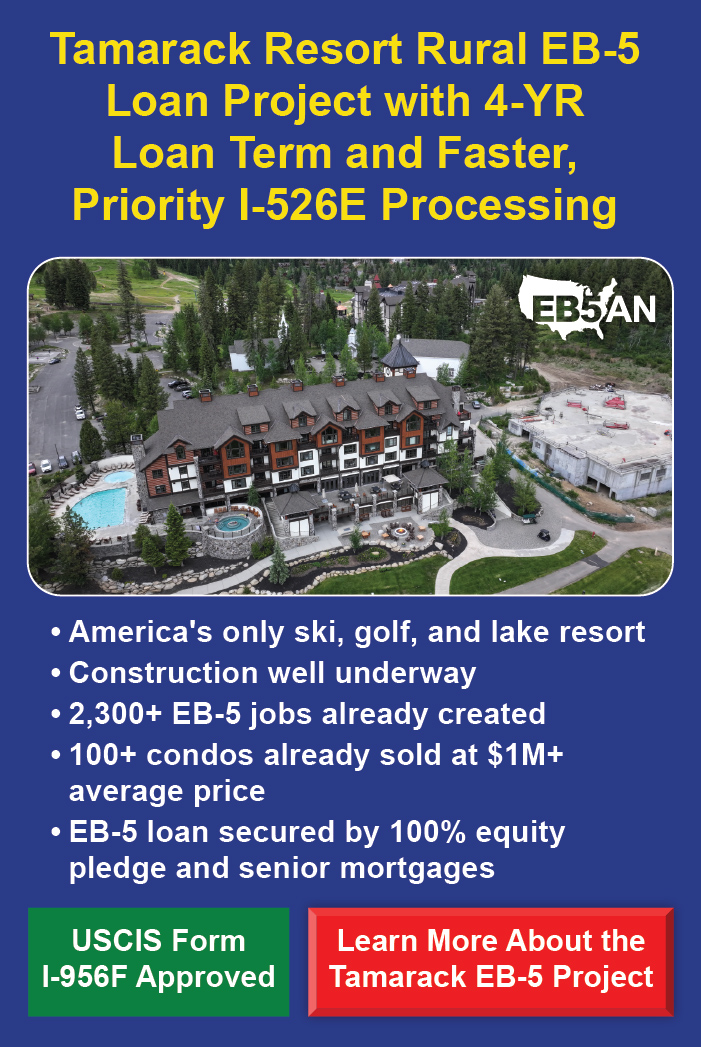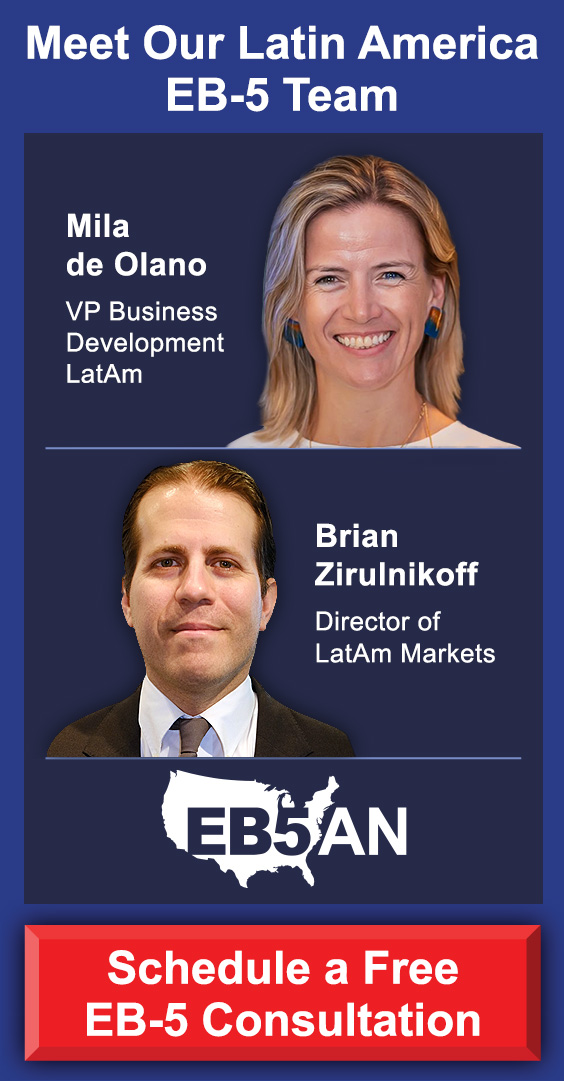For an EB-5 immigrant investor to be considered eligible for a green card through the EB-5 program, the investment capital used for their EB-5 initial investment must be kept “at-risk” for two years from the date the capital is made available to the EB-5 project that creates jobs.
When we refer to an “at-risk” investment, this means that an EB-5 investment carries a certain degree of financial risk.
In other words, the possibility of losing some or all of the invested capital always exists.
This, however, does not mean that an EB-5 investment is risky. These investments are typically well structured and planned, with solid due diligence performed.
It is the responsibility of the investor to check that they are satisfied with the potential of the investment.
For many new commercial enterprises (NCEs), repayment of EB-5 capital investment doesn’t begin until:
- His or her investment has been “placed at risk” and “made available” to the JCE for at least two years.
- His or her investment must have created at least 10 jobs.
But, what happens if an immigrant investor’s chosen enterprise is ready to repay their loan but the investor’s two-year conditional residency has been extended due to delays?
If an investor’s EB-5 capital is repaid before the end of their conditional residency, their EB-5 investment capital must be “redeployed” back into an enterprise, or the immigrant investor’s chances for a green card could be jeopardized.
Due to a 2022 reform of the EB-5 Immigrant Investor Program, USCIS has offered updated guidance on the legal means to redeploy EB-5 capital.
Revisions to the USCIS Policy Manual
On March 15th, 2022 the U.S. Congress passed the EB-5 Reform and Integrity Act of 2022.
Key Point: What Is The EB-5 Reform and Integrity Act?
The EB-5 Reform and Integrity Act is legislation that was introduced in the United States Congress with the aim of reforming and strengthening the EB-5 Immigrant Investor Program. This act was restructured in 2022 to prevent fraud, as well as promote and reform foreign capital investment and job creation in the United States.
The most notable aim of this bill was to restart the EB-5 Regional Center Program with greater scrutiny and oversight of all prospective EB-5 regional centers.
There were also reforms made to redeployment policies for EB-5 capital.
The EB-5 Reform and Integrity Act of 2022 Act officially recognizes ‘redeployment’ of capital as capital that gets paid back to the enterprise before the end of the investor’s sustainment period.
As per the USCIS EB-5 guidance on redeployment, the key components of the revised redeployment policies include:
- Financial instrument purchases do not qualify for redeployment.
- The enterprise must have repaid the EB-5 capital in order for it to be redeployed.
- The original EB-5 project’s business plan must have been implemented without material change.
With the passage of the 2022 bill, EB-5 capital can now be redeployed throughout the United States and not just within the approved regional center area.
Most drastically, as per the new EB-5 bill, USCIS is required to terminate a regional center if any of its new commercial enterprises violates the aforementioned USCIS EB-5 guidance on redeployment.
However, according to the bill, a qualified petition or conditional residence period can still remain valid, even if the investment was made through a terminated regional center.
Discover how these changes potentially affect EB-5 immigrant investor visas.
Green Card Requirements
One of the basic requirements to secure permanent green cards for an EB-5 investor and their qualifying family members through the EB-5 program, is that immigrant investors must make a qualified investment of $1,050,000 in an NCE, or $800,000 if the NCE is located in a targeted employment area (TEA).
The investment must maintain an at-risk investment status through the conditional residence period. This period is usually two years and it begins the moment the funds are transferred to the JCE.
Evidence of meeting these and all other requirements of the EB-5 program is presented through an I-829 petition, which is filed within the last 90 days of the conditional residence period.
Upon approval, the investor and their eligible family members may be granted the removal of conditions on their green card.
EB-5 investment funds are released only after the conditional residency period is completed. This period begins upon the issuance of a conditional green card and not upon the approval of the I-526 petition.
USCIS’ Redeployment Policy
For those immigrant investors who filed their I-526 petitions prior to the March 15th, 2022 enactment of the EB-5 Reform and Integrity Act, their EB-5 capital needed to remain ‘at-risk’ from the time of their I-526 approval through the end of their two-year conditional permanent residency period.
However, for immigrant investors who file their I-526 or I-526E petitions after March 15th, 2022, their capital simply needs to be invested and remain ‘at-risk’ for two years from the time of investment in a job-creating entity (JCE), provided that their investment meets all other requirements of the EB-5 program, such as the creation of 10 full-time jobs.
Where Capital Redeployment Fits into the EB-5 Immigrant Investor Program
Initially, loan or equity agreements involving EB-5 regional center investments were meant to be structured around the EB-5 immigration process timeline.
Most were (and still are) created with five-year terms.
Typically, the project investment roadmap begins with an EB5 applicant investing in a new commercial enterprise.
However, as demand for EB-5 visas increased and the government shutdown prompted by the COVID-19 pandemic decimated USCIS’ adjudication capabilities, the backlog of immigrant investors awaiting I-526 petition adjudication quickly outgrew the traditional two-year waiting period.
This backlog is known as visa retrogression and some investors have had to wait up to a decade for their visa to be processed. This means that their five-year term ended before they got their visa.
Because USCIS policy does not allow for capital to sit idly in an NCE’s account, the only option, historically, has been to reinvest the investment funds. In other words, the capital needed to be redeployed to maintain the required “at-risk” status.
By reducing what is known as the ‘sustainment period’ for EB-5 capital to two years from the time of initial capital deployment in the JCE, instead of two years from I-526 approval, USCIS has effectively gotten rid of the need for redeployment in most new commercial enterprises.
This change indicates that immigrant investors who have invested in an enterprise and kept their EB 5 capital ‘at risk’ for two years could receive a return on their EB-5 capital investment, even before receiving the results of their I-526 or I-526E petition adjudication, or before achieving conditional permanent resident status.
This may encourage future immigrant investors to seek out EB 5 projects with an earlier potential for return.
It may also erode subscriptions to longer-term NCEs or regional center projects in the future, as project managers will no longer be able to depend as reliably on the influx of EB-5 capital to sustain business operations during the typically long wait times for I-526 or I-526E adjudication.
Avoiding Material Changes During EB-5 Capital Redeployment
There are several redeployment criteria that must be met to avoid USCIS red-flagging an investment. Certain funding modifications may be viewed as material changes.
To ensure that capital is not redeployed prematurely and not viewed as a material change, the following criteria apply:
- The original EB-5 investment was fully deployed and all job-creation requirements were met.
- Most, if not all, project goals outlined in the original business plan were achieved.
- The original capital was returned—or at least made available to—the enterprise for reinvestment.
Material changes generally include changes that vastly alter the scope of a project or affect the structure of funding an investment.
The March 2022 EB-5 Reform and Integrity Act provided updated clarifications on how immigrant investors can remain EB-5 compliant throughout the redeployment process.
The policy now sets out where and when a redeployment can happen, and what kinds of businesses and activities qualify.
Key Components of the Policy Update on EB-5 Capital Redeployment
Although it is the regional center operators and the developers who work with regional center sponsors that will feel the greatest impact of the redeployment policy changes, there are very real changes for EB-5 investors themselves, as well.
Below is a summary of five key policy clarifications and their primary implications.
1. EB-5 capital must be reused for commercial activity
Purchasing financial instruments and security investments do not qualify as meeting EB-5’s ‘at-risk’ capital requirement.
Since financial instrument transactions are no longer valid, redeployment into stocks or with a brokerage firm will put investors’ permanent green cards at risk.
2. Redeployed EB-5 capital may be used for a variety of lawful business activities, provided these activities fall within the scope of the NCE
USCIS is proving to be quite flexible on qualifying commercial activities, and it may allow the enterprise to adjust its scope by amending the original partnership and operating agreements.
3. EB-5 capital may be redeployed throughout the United States, not merely within the same geographical area as the original
Previously, USCIS redeployment policies stipulated that EB-5 capital needed to be redeployed in the original regional center’s USCIS-approved geographic area. This is no longer the case.
This has significant implications for regional centers and developers working with regional center sponsors.
Smaller regional centers no longer need to apply for the expansion of their geographic coverage to provide more options for investors who are seeking redeployment of their capital.
For example, if a regional center covered only three counties, all redeployments would have had to occur in that three-county area. To expand the area a regional center’s license covers, the regional center operator previously needed to file a Form I-956 amendment. The regional center would then potentially be able to extend its geographic coverage to 20 counties instead, which would create far more investment opportunities for investors and developers alike.
However, with the March 2022 update to USCIS guidance on redeployment, this additional processing time is no longer required.
Immigrant investors and project developers seeking regional center sponsorship are now able to have a larger geographic footprint, which allows greater flexibility with redeployment.
4. EB-5 redeployments should occur within one year of recovery of EB-5 investment funds
USCIS is also demonstrating flexibility for delays that are beyond the control of investors and other stakeholders.
Depending on where an EB-5 investor is in the EB-5 timeline, these changes may bring about a need for quick action to alleviate any risk to their visas—especially when delays come about through no fault of their own.
Risk Management Considerations
In many cases, EB-5 redeployment of capital will not be necessary if the EB-5 project is on schedule and USCIS processing times are back at normal, pre-pandemic levels. However, in the event that an immigrant investor does need to redeploy their capital, there are many options and considerations:
Capital can be loaned to the original enterprise or job-creating entity, though there are risks to this option
- The NCE or job creating entity may not remain as efficient in producing a return on investment as they initially were. The redeployed capital may take longer than an investor would desire, especially if the new project is longer-term or more complex.
- Investors will not be subject to the original job creation requirement, provided that the requirement was already fulfilled from the initial investment.
Investments outside of the NCE or regional center
- The updated USCIS EB-5 guidance on redeployment states that redeployment may occur anywhere within the United States, as long as the capital is in a commercial venture and “at-risk” for the length of the investment.
- This vast increase in options for EB-5 redeployment can result in higher returns and higher liquidity than the original NCE or job creating entity may have been able to provide.
Duration of redeployment
- Since the “sustainment period” of the “at-risk” requirement has changed, EB-5 capital no longer needs to be held “at-risk” until an investor receives I-829 approval. This, in many cases, eliminates the need to redeploy capital at all, as long as it was “at-risk” and invested in the NCE for a minimum of two years.
Working with EB5AN to Expedite EB-5 Capital Redeployment
With more than 10 regional centers, some extending through multiple states or covering entire states, EB5AN is a trusted partner and project sponsor.
There are several benefits to working with EB5AN to reduce investors’ immigration risk:
- Redeployment flexibility due to expanded regional center coverage.
- Expertise that leads to best-in-class fund management.
- Full project transparency and a dedication to EB-5 program compliance.
The EB5AN team also has extensive experience in filing Form I-956 petitions and expansion amendments for regional center operators, with 150 USCIS approvals to date. We also have experience with expansion applications for larger geographic areas.
To learn more about how EB5AN can assist you with your specific EB-5 immigrant investor projects, contact us today.










